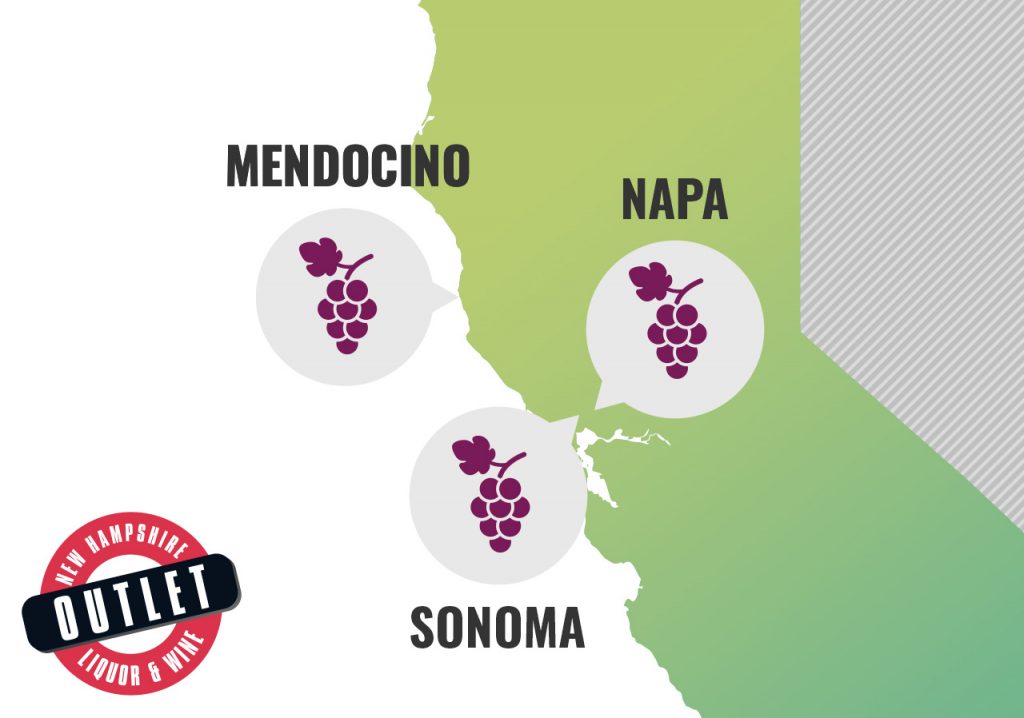In honor of California Wine Month this September, we’re inviting you on a delicious virtual taste-tour through three of the Golden State’s vinous hot spots. With stops in Napa, Sonoma, and one slightly off-the-beaten-track locale—we’ll touch on what makes California wine the massive sensation it is today and reveal the unlikely story of how these wines landed on the world stage in the first place. (Hint: It involves overturning the applecart of some pretty powerful people in the wine world.)
First stop, Mendocino
We begin at our northernmost point, Mendocino County (“Mendo,” to the locals). Framed by coastal ranges and the Pacific Ocean to the west and by the mighty Mayacamas Mountains to the east, Mendo is a warm—really warm—and dry place that’s known for its bold, rustic reds.
There are a few pockets of vines here that date back to the early 1900s; a tangle of varieties like Carignan, Zinfandel, Petite Sirah, and Barbera that are often harvested together and bottled as “field blends,” a very traditional (and delicious) style.
Anderson Valley is a real jewel in Mendocino’s crown. One of 10 official American Viticultural Areas (AVAs), it’s particularly famous for its chilly mornings and evenings, and beneficial fog that rolls in off the water. It’s an excellent place to grow cooler-climate stars like Pinot Noir, Pinot Gris, and Gewürztraminer.
Now Entering: Sonoma
Sonoma is less “hustle-n-bustle” (like our last stop) and more “take-it-easy.” This bucolic little corner of California boasts a huge array of grapes that grow well, but thanks to the cooler, Burgundy-like climate, Chardonnay and Pinot Noir in particular thrive here.
Unlike many other regions in California, Sonoma owes its wine-growing roots to Russian immigrants, not Spanish. Russian fur traders arrived by way of Alaska and were the first to plant vines. But, post-Gold Rush-bonanza, Italian, French, and German immigrants whose fortunes literally didn’t pan out made the trek north, lured by the promise of fertile lands and waters.
The aptly named Russian River Valley AVA, along with a host of other prestigious districts (including Anderson Valley, Los Carneros, and more) set the pace for phenomenal winemaking and are definitely names to look out for on a label.
Last Stop, Napa
Welcome to the center of the American winemaking universe. Without fear of hyperbole, Napa Valley is the most famous and sought-after wine region in the whole of the U.S. Pretty remarkable for a place that’s a mere five miles wide and that produces less than 5% of California’s total wine.
An hour and a half north of San Francisco, Napa is a mecca for lovers of Cabernet Sauvignon, its signature grape variety. But if Cab is King, then Chardonnay surely is Queen—Napa’s known for producing exceptional (and extravagantly pricey) bottles of both.
But it wasn’t until 1976 that Napa (and the U.S.) really stepped onto the world wine stage. Stepped? Sorry, make that barged. British wine merchant Stephen Spurrier was so impressed by what he tasted in Napa that he arranged a formal blind taste-off in Paris, pitting France’s Goliaths—Bordeaux and Burgundy—against the Cab and Chardonnay newcomers from the Golden State. France was trounced. And California? Never looked back.
Which, as it happens, is very good news for you. Check out our selection of California wines in stores and online today to take your own virtual tour of California wine country.
